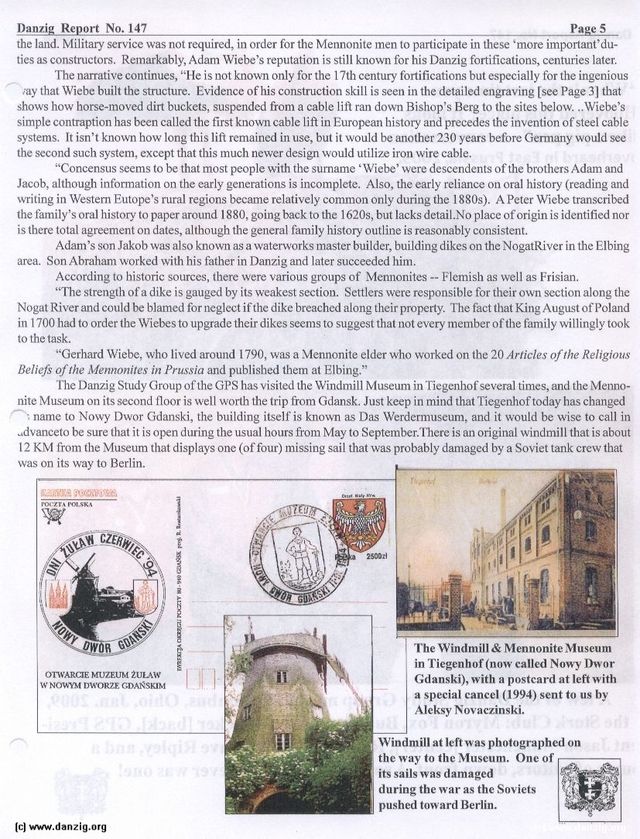
= Mennonite Expansion in Europe.
Adam Wiebe's story closly parallels Mennonite migration in Europe. It's been long known that Mennonites (with Frisians among them) were welcomed in the plains of East Prussia to channel waterways, built dikes, and cultivate the land. Military service was not required, in order for the Mennonite men to participate in these 'more important' duties as constructors. Remarkably, Adam Wiebe's reputation is still known for his Danzig fortifications, centuries later.
The narrative continues, "He is not known only for the 17th century fortifications but especially for the ingenious way that Wiebe built the structure. Evidence of his construction skill is seen in the detailed engraving {see Page 3} that shows how horse-moved dirt bucketts, suspendedn from a cable lift ran down Bishop's Berg to thr sited below." Wiebe's simple contraption has been called the first known cable lift in European history and precedes the invention of steel cable systems. It isn't known how long this lift remained in use, but it would be another 230 years before Germany would see the second such system, exept that this much newer design would utilize iron wire cable.
Consensus seems to be that most people with the surname 'Wiebe' were descendentsof the brothers Adam and Jacob, although information on the early generations is incomplete. Also, the early reliance on oral history (readingand writing in Western Europe's rural regions became relativly common only during the 1880s). A Peter Wiebe transcribed the family's oral history to paper around 1880, going back to the 1620s, but lacks detail. No place of origin is identified nor is there total agreement on dates, although the general falily history outline is reasonably consistent.
Adam's son Jakob was also known as a waterwork master builder, building dikes on the Nogat River in the Elbing area. Son Abraham worked with his father in Danzig and later succeeded him.
According to historic surces, there were various groups of Mennonites - Flemish as well as Frisian.
The strength of a dike is gauged by its weakest section. Settlers were responsible for their own section along the Nogat River and could be blamed for neglect if the dike breached along theit property. The fact that King August of Poland in 1700 had to order the Wiebes to upgrade their dikes seems to suggest that not every member of the family willingly took to the tast.
"Gerhard Wiebe, who lived arround 1790, was a Mennonite elder who worked on the '20 Articles of the Religious Beliefs of the Mennonites in Prussia' and published them at Elbing.
The Danzig Study Group of the GPS has visited the Windmill Museum in Tiegenhof several times, and the Mennonite Museum on its second floor is well worth the trip from Gdansk. Just keep in mind that Tiegehof today has changed its name to Nowy Dwor Gdanski, the building itself is known as Das Werdermuseum, and it would be wise to call in advance to be sure that it is open during the usual hours from May to September. There is an original windmill that is about 12 Km from the Museum that displays one (of four) missing sail that was probably damaged by a Soviet tank crew that was on its way to Berlin.
*- The Windmill & Mennonite Museum in Tiegenhiof (now called Nowy Dwor Gdanski), with a postcard at left with a special cancel (1994) send to us by Aleksy Novaczinski.
*- Windmill at left was photograped on the way to the Museum. One of its sails was damaged during the war as the Soviets pushed toward Berlin.
Danzig Report Nr. 147.
Hits: 2425
Added: 16/02/2010
Copyright: 2024 Danzig.org

